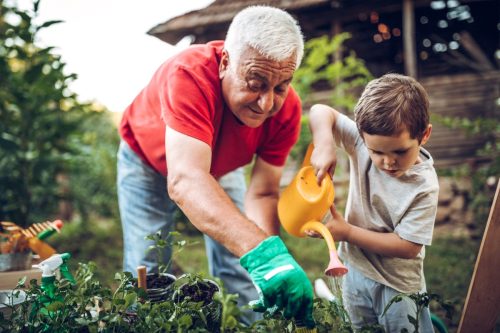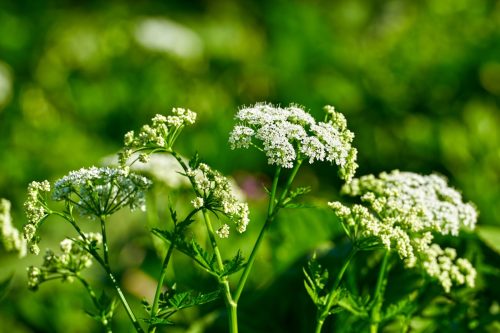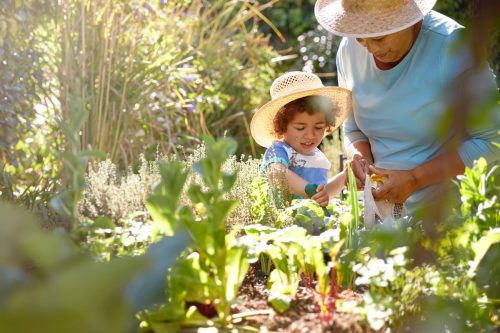If You See These Flowers in Your Yard, Pull Them Immediately, Experts Warn
This plant can cause fatal consequences if not dealt with correctly.
Blooming flowers can make any yard look fresh, especially through the spring and summer. But even the most beautiful flowers can have a dark side. There are countless poisonous plants that can cause harm to you or your furry friends, from wisteria to azaleas. And if you're not up-to-date on your flower knowledge, you might not even realize some of the plants growing in your own hard could be toxic. Experts are now warning about one flower so dangerous to humans that you should pull it immediately. Read on to find out which plant you should watch out for in your yard.
READ THIS NEXT: If You Have This Tree in Your Yard, Cut It Down Now, Officials Warn.
There are plenty of hazards in your yard.

A large yard is a luxury in many ways, but it also allows more room for potential hazards. As it turns out, there are a number of dangers that could be lurking in your own yard. If you have birdbaths and bird feeders outside your home, for example, you could be drawing mice and snakes inside.
Sometimes the danger is more to your surroundings, as with invasive plants. Recently, experts warned homeowners to watch out for garlic mustard lingering in their flower beds or bushes, as this plant can threaten surrounding wildlife by crowding out native species.
But other plants pose a more immediate danger.
One flower in your yard could be very dangerous.

When watching out for dangerous things in your yard, make sure to give your flowers a close look. If you see clusters of white and purple flowers with tall hollow stems, you could be dealing with poison hemlock, CBS-affiliate WHIO-TV in Dayton, Ohio, recently reported. This plant, which is not native to the U.S., has quickly spread across the country after being brought here, and is now banned as a prohibited noxious weed—making it illegal to sell or distribute.
Megan Rude, the lead conservation technician at Five Rivers Metroparks in Vandalia, Ohio, told the news outlet that you should get rid of these flowers immediately if you see them in your yard. The plant is true to its name and is poisonous to humans and animals. "You can either hand pull or hand dig the plants up—if there's just a couple of them, you can mow them," Rude said.
RELATED: For more up-to-date information, sign up for our daily newsletter.
Poison hemlock plants may be especially toxic right now.

Poison hemlock is "extremely poisonous to humans," according to the U.S. Department of Agriculture (USDA). As Health magazine explains, the plant contains toxic compounds such as coniine, g-coniceine, and piperidine alkaloids. The USDA warns that all parts of the plant—its leaves, stem, fruit, and root—are toxic. "Leaves are especially poisonous in the spring, up to the time the plant flowers," the USDA notes. The plant typically blooms from May to August, per the Minnesota Department of Agriculture.
Some experts believe that the plant can cause skin rashes. With that in mind, Rude told WHIO-TV that if you are removing poison hemlock from your yard, you should make sure to wear gloves. The Minnesota Department of Agriculture also recommends wearing long sleeves, long pants, and close-toe boots when dealing with poison hemlock—just to be safe.
Ingesting any part of this plant could have fatal consequences.

But the main concern with poison hemlock comes from it being ingested, as people can be poisoned by eating any part of the hemlock plant, per the USDA. Sarah Shafer, MD, an assistant professor of emergency medicine at Baylor College of Medicine, told Health that many people end up accidentally eating the plant.
"People get poisoned because they mistake it for a wild parsley or wild carrot," she explained, adding that some people even "pick it out of their garden and put it in a salad," believing it to be something they had grown. According to the Minnesota Department of Agriculture, poison hemlock produces an abundant number seeds that can easily and unknowingly be spread by mowing and other equipment.
The toxic compounds in poison hemlock can result in muscle paralysis or death from respiratory failure. Be sure to watch out for signs of hemlock poisoning, which can appear anywhere between 30 minutes to hours after you ingest the plant, according to Healthline. Common symptoms include trembling, burning in the digestive tract, increased salivation, dilated pupils, muscle pain, rapid heart rate, loss of speech, and convulsions.
READ THIS NEXT: If You See This Flower in Your Yard, Call Local Officials Immediately.






















